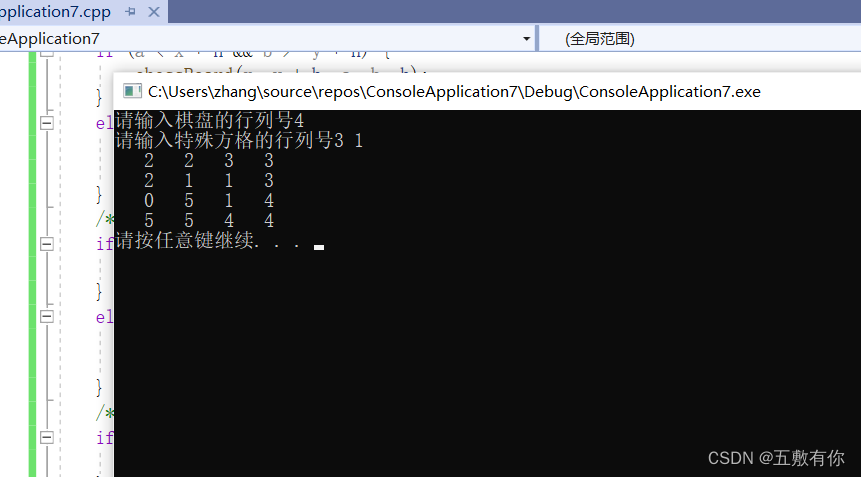本文主要是介绍L型骨牌覆盖问题。,希望对大家解决编程问题提供一定的参考价值,需要的开发者们随着小编来一起学习吧!
问题:解决一个2k*2k的特殊棋牌上的L型骨牌覆盖问题。
思路:
棋盘覆盖实现的基本方法为分治法
当k=0时(1ⅹ1棋盘),及特殊方格,骨牌数为0
当k >0时,将2kⅹ2k棋盘分割为4个2k-1ⅹ2k-1子棋盘了
特殊方格位于4个较小子棋盘之一中,而其余3个子棋盘中无特殊方格。
在递归之前要将原问题转化为4个较小规模的相同子问题。(用一个L型骨牌覆盖这3个子棋盘的会合处)
这三个子棋盘上被L型骨牌覆盖的方格就成为该棋盘上的特殊方格,从而将问题分解为4个较小规模的棋盘覆盖问题。
递归地使用这种分割方法,直至棋盘简化为1ⅹ1棋盘,就结束递归。
具体实现
对每个子棋盘按照左上,右上,右下,左下的顺时针顺序铺满棋盘。(顺序不一样,铺出来的编号也不一样)
每次都对分割后的四个小方块进行判断,判断特殊方格是否在里面。
如果特殊方块在里面,这直接递归下去即可,
如果不在,这根据分割的四个方块的不同位置,把右下角、左下角、左上角、右上角的方格标记为特殊方块,然后继续递归。
在递归函数里,还要有一个变量h来记录边的方格数,每次对方块进行划分时,边的方格数都会减半,这个变量是为了方便判断特殊方格的位置。
代码实现
x:棋盘左上角方格的行号
y:棋盘左上角方格的列号
a:特殊方格的行号
b:特殊方格的列号
length:2k,棋盘规模:2kⅹ2k
源码:
#include<iostream>#include<iomanip> using namespace std;int matrix[100][100];int num = 0;void chessBoard(int x, int y, int a, int b, int length);int main(){int a, b, length;cout << "请输入棋盘的行列号";cin >> length;cout << "请输入特殊方格的行列号";cin >> a >> b;matrix[a][b] = 0;chessBoard(1, 1, a, b, length);for (int i = 1; i <= length; i++) {for (int j = 1; j <= length; j++) {cout << setw(4) << matrix[i][j];}cout << endl;}system("pause");return 0;}void chessBoard(int x, int y, int a, int b, int length) {if (length == 1) {return;}int h = length / 2; int t = ++num; /*左上角*/if (a < x + h && b < y + h) { chessBoard(x, y, a, b, h);}else { matrix[x + h - 1][y + h - 1] = t;chessBoard(x, y, x + h - 1, y + h - 1, h);}/*右上角*/if (a < x + h && b >= y + h) { chessBoard(x, y + h, a, b, h);}else { matrix[x + h - 1][y + h] = t;chessBoard(x, y + h, x + h - 1, y + h, h);}/*右下角*/if (a >= x + h && b >= y + h) { chessBoard(x + h, y + h, a, b, h);}else { matrix[x + h][y + h] = t;chessBoard(x + h, y + h, x + h, y + h, h);}/*左下角*/if (a >= x + h && b < y + h) { chessBoard(x + h, y, a, b, h);}else { matrix[x + h][y + h - 1] = t;chessBoard(x + h, y, x + h, y + h - 1, h);}}运行截图:

这篇关于L型骨牌覆盖问题。的文章就介绍到这儿,希望我们推荐的文章对编程师们有所帮助!






